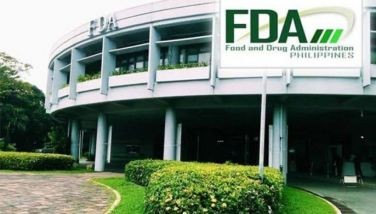Eight reasons to be proud of our past
June 4, 2006 | 12:00am
It’s ironic that, as we observe Flag Month, many people are unaware of their nation’s historic past. Manileños in jeeps don’t even know they’re passing by a Chinese parian in an ancient district of Manila. I thought I’d exhume historical notes via the Philippine flag, like the eight rays that symbolize the eight provinces of Luzon – Manila, Bulacan, Pampanga, Nueva Ecija, Tarlac, Cavite, Laguna, and Batangas – which revolted against the Spanish colonial government. Why do I remember these provinces? Because they make me proud to be a Filipino of Spanish, Chinese, and Malayan descent.
Just imagine Manila’s landscape in the last decade of the 19th century when it was considered the Venice of the Far East by foreigners, who marveled at our oyster-shell windows and heard about the Philippines from the labels of cigarette boxes.
In Manila lived 350,000 "souls" broken into these ethnic groups: 50,000 Chinese; 5,000 Spaniards; 150 Germans; 90 English, and four Americans. From photographs, one takes note of the new breed of natives, a combination of the Chinese’s slinky eyes, flat noses, and high cheekbones, or perhaps an aquiline nose with heavy eyelashes from a Spanish ancestor. Evolution! Majority of the souls in Manila came to be called mestizos.
Cash was not needed then; we had the "chit" system. No one paid in Mexican coins, which was the only existing currency of our islands. One simply signed an IOU for the amount purchased in any shop, thought no more about it until the end of the month. Collectors went around, going to private homes and establishments, with all the signed chits, dragging a wheelbarrow to pour the coins into and walked away with the "loot."
Cavite had a shipyard for the repair of galleons. Most of her local estates were owned by religious orders: the Recollects, Dominicans, and Franciscans. It is no wonder she became the hotbed of the Philippine revolution. The mutiny of the shipyard workers and the creoles led by a certain Sergeant De la Madrid reawakened our aspirations for freedom. The mutiny was repealed, and the actors and cohorts were either executed or deported. One of those deported to a foreign land was my great-great-grandfather Don Crisanto delos Reyes, who contributed financially through his shipping and chandlery business in Binondo. He was taken on the ship and brought to Fernando Poo (familiar, right?) in Africa, and when the ship reached Marseilles, France, he jumped ship and escaped. The rest of those who were deported were sent to the Marianas, and others to Jolo. It was at the same time that the three Filipino priests, Fathers Mariano Gomez, Jacinto Zamora, and Jose Burgos, were implicated and garroted in Bagumbayan, now the Rizal Park, in Feb. 17, 1872.
The province of Laguna is where our national hero Jose Rizal was born and raised in the most charming, huge adobe house, an example of Spanish architecture, located near Calamba Church.
Captain Juan de Salcedo discovered Laguna de Bay, the largest freshwater lake in the Philippines and second in Asia, on Aug. 19, 1571.
Salcedo, grandson of Miguel Lopez de Legazpi, the Philippines’ first Spanish-designated governor, sailed down the lake from the Pasig River. The Spaniards called the body of water "laguna," meaning "lake." Salcedo who had landed in "bay" or "baybay," meaning "lakeside," named the lake Laguna de Bay. Laguna de Bay was the trading route of Chinese junks sailing from Manila Bay through Pasig to reach the villages around the lake. Thai and Vietnamese merchants bartered their potteries with local products in the 14th and 15th century by the lake.
In 1570, Martin de Goiti and Juan de Salcedo, two Spanish generals, explored the coast of Batangas on their way to Manila and came upon a Malay settlement at the mouth of Taal River.
The name "Batangas" is derived from the word "batang," a native term for the numerous logs in the Calumpang River. Originally, Batangas was composed of Mindoro, Marinduque, southeast of Laguna, and as far as Camarines in Bicol. Balayan was the capital of the province for 135 years, from 1597 to 1732. It was here as a seven-year-old girl that I went for weekends with the Lopez clan, the parents and grandparents of Maribeth and Diana Jean, because my granduncle, Pepe Lopez Manzano, married their grandaunt Ninay. Batangas is where the smallest volcano in the world caused devastations to its town, Taal, that lies buried around her.
During the Spanish-American War, outstanding Batangueños, like Apolinario Mabini, the "Brains of the Revolution"; Marcela Agoncillo, who sewed the present Philippine flag; and General Miguel Malvar, uncle to our Nats Mendoza of Tarlac and recognized as the last Filipino general to surrender to the Americans, became Filipino heroes.
Why was Bulacan called so? Because the province produced cotton. And cotton in Tagalog is bulak. It was in this province that the Mololos Congress affirmed the existence of our Philippine Republic. It was where the first university, Unibersidad Literaria, and the first Military Academy in Malolos was established in 1898 under the leadership of General Antonio Luna.
The province of Pampanga was established in December 1571. Kapampangans traded in Sumatra before the Spaniards reached the Philippines. As proof, Jesuit priest Fr. Francisco Colin mentions:
"The Pampangos, according to tradition, came from the largest island of the Orient, which is known as Sumatra of Tropobana; they include it with the Aurea Chersonese. In the middle of this great island of Sumatra is a lake in whose circumference many and various tribes of the people have their homes. Here came a Pampango who had lost his way; and it was there, in that place who had the same features, language and dress, he approached and conversed with them in his own Pampango dialect and they answered him in the same tongue. An old man in their group said: ‘You are descendants of the lost people of this island who in the remote past sailed away to settle in other lands and nothing more was heard of them’." That island was the Philippines.
Nueva Ecija in 1898, became the seat of the revolutionary government. In June that year, General Antonio Luna was assassinated in Cabanatuan in one of the most tragic episodes of the revolutionary war.
In World War II, Cabanatuan was the site of an infamous camp for American prisoners of war run by the Japanese Imperial Army. In January 1945, Filipino guerrillas liberated the American captives of the camp. A memorial stands at the site in recognition of the bravery and fortitude of American and Filipino fighters in resisting the Japanese.
Tarlac was originally a part of the provinces of Pangasinan and Pampanga. Tarlac became the seat of the first Philippine Republic in March 1899 for a month when Emilio Aguinaldo abandoned the former at Malolos, Bulacan. His seat of government was moved to Nueva Ecija in Aguinaldo’s attempt to elude the pursuing Americans.
On Oct. 23, 1899, Gregorio Aglipay, military vicar general of the revolutionary forces, called the Filipino clergy to a conference in Paniqui, Tarlac. There, they drafted the constitution of the Philippine Independent Church. They called for the Filipinization of the clergy, which eventually led to a schism in the Roman Catholic Church in the Philippines.
During World War II, Camp O’Donnell in Capas became the terminal point of the infamous Death March, involving Filipino and American soldiers who surrendered in Bataan on April 9, 1942. The camp was so overcrowded that many allied prisoners who survived the grueling march died of hunger and disease.
Love of country shouldn’t obliterate love of a town, province or region. On the contrary, one who does not love his hometown or province will find it difficult to love his nation.
In Manila lived 350,000 "souls" broken into these ethnic groups: 50,000 Chinese; 5,000 Spaniards; 150 Germans; 90 English, and four Americans. From photographs, one takes note of the new breed of natives, a combination of the Chinese’s slinky eyes, flat noses, and high cheekbones, or perhaps an aquiline nose with heavy eyelashes from a Spanish ancestor. Evolution! Majority of the souls in Manila came to be called mestizos.
Cash was not needed then; we had the "chit" system. No one paid in Mexican coins, which was the only existing currency of our islands. One simply signed an IOU for the amount purchased in any shop, thought no more about it until the end of the month. Collectors went around, going to private homes and establishments, with all the signed chits, dragging a wheelbarrow to pour the coins into and walked away with the "loot."
Captain Juan de Salcedo discovered Laguna de Bay, the largest freshwater lake in the Philippines and second in Asia, on Aug. 19, 1571.
Salcedo, grandson of Miguel Lopez de Legazpi, the Philippines’ first Spanish-designated governor, sailed down the lake from the Pasig River. The Spaniards called the body of water "laguna," meaning "lake." Salcedo who had landed in "bay" or "baybay," meaning "lakeside," named the lake Laguna de Bay. Laguna de Bay was the trading route of Chinese junks sailing from Manila Bay through Pasig to reach the villages around the lake. Thai and Vietnamese merchants bartered their potteries with local products in the 14th and 15th century by the lake.
The name "Batangas" is derived from the word "batang," a native term for the numerous logs in the Calumpang River. Originally, Batangas was composed of Mindoro, Marinduque, southeast of Laguna, and as far as Camarines in Bicol. Balayan was the capital of the province for 135 years, from 1597 to 1732. It was here as a seven-year-old girl that I went for weekends with the Lopez clan, the parents and grandparents of Maribeth and Diana Jean, because my granduncle, Pepe Lopez Manzano, married their grandaunt Ninay. Batangas is where the smallest volcano in the world caused devastations to its town, Taal, that lies buried around her.
During the Spanish-American War, outstanding Batangueños, like Apolinario Mabini, the "Brains of the Revolution"; Marcela Agoncillo, who sewed the present Philippine flag; and General Miguel Malvar, uncle to our Nats Mendoza of Tarlac and recognized as the last Filipino general to surrender to the Americans, became Filipino heroes.
The province of Pampanga was established in December 1571. Kapampangans traded in Sumatra before the Spaniards reached the Philippines. As proof, Jesuit priest Fr. Francisco Colin mentions:
"The Pampangos, according to tradition, came from the largest island of the Orient, which is known as Sumatra of Tropobana; they include it with the Aurea Chersonese. In the middle of this great island of Sumatra is a lake in whose circumference many and various tribes of the people have their homes. Here came a Pampango who had lost his way; and it was there, in that place who had the same features, language and dress, he approached and conversed with them in his own Pampango dialect and they answered him in the same tongue. An old man in their group said: ‘You are descendants of the lost people of this island who in the remote past sailed away to settle in other lands and nothing more was heard of them’." That island was the Philippines.
Nueva Ecija in 1898, became the seat of the revolutionary government. In June that year, General Antonio Luna was assassinated in Cabanatuan in one of the most tragic episodes of the revolutionary war.
In World War II, Cabanatuan was the site of an infamous camp for American prisoners of war run by the Japanese Imperial Army. In January 1945, Filipino guerrillas liberated the American captives of the camp. A memorial stands at the site in recognition of the bravery and fortitude of American and Filipino fighters in resisting the Japanese.
On Oct. 23, 1899, Gregorio Aglipay, military vicar general of the revolutionary forces, called the Filipino clergy to a conference in Paniqui, Tarlac. There, they drafted the constitution of the Philippine Independent Church. They called for the Filipinization of the clergy, which eventually led to a schism in the Roman Catholic Church in the Philippines.
During World War II, Camp O’Donnell in Capas became the terminal point of the infamous Death March, involving Filipino and American soldiers who surrendered in Bataan on April 9, 1942. The camp was so overcrowded that many allied prisoners who survived the grueling march died of hunger and disease.
BrandSpace Articles
<
>















